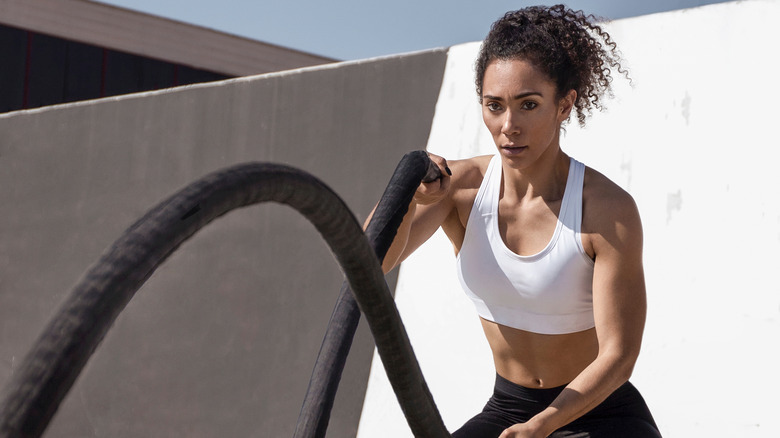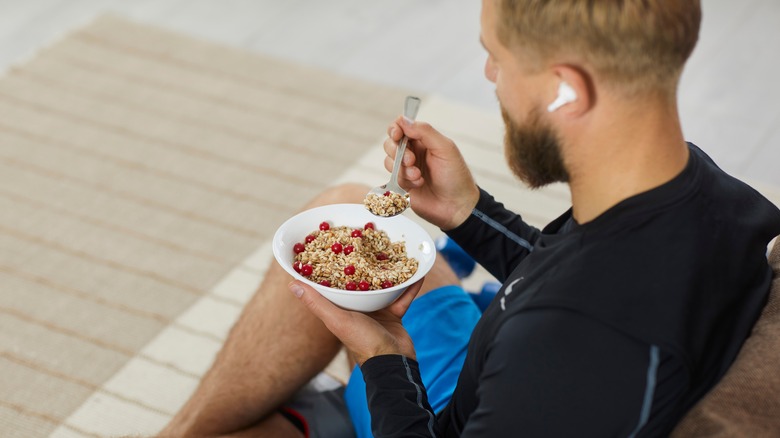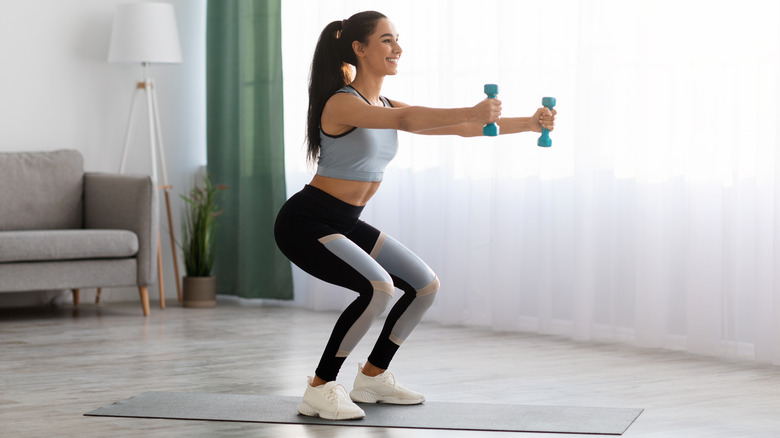Can Fat Turn Into Muscle?
True or false: muscle weighs more than fat. If you said true, you're not the only one who believes this myth. As it turns out, five pounds of muscle weighs the same as five pounds of fat. "The difference is that muscle is much more dense than body fat," Atlanta-based exercise physiologist Katie Heimburger told WebMD. Therefore, a pound of muscle will take up less space in your body than a pound of fat. Furthermore, muscle has better blood supply than body fat, which helps burn more calories at rest.
So what about the popular notion that body fat can turn into muscle, and muscle can turn into fat? Well, that's another misconception. No doubt about it, you can gain and burn fat, just as you can build and lose muscle (per Best Life). But if you're thinking that one can morph into the other, think again. Fat and muscle are different kinds of tissue. Simply put, you'd have better luck trying to turn peaches into plums. What's more important is adopting ways to optimize fat-burning and muscle-building for healthy outcomes.
How to create a fat-burning, muscle-building diet
When it comes to your diet, you can achieve both goals simultaneously once you pinpoint your "caloric sweet spot," according to Body Building. That magic number of calories is small enough to create a deficit that helps you lose body fat but large enough to build muscle. Beyond the right caloric intake, the secret to burning fat and building muscle lies in what you consume, specifically protein, carbs, and fat — collectively known as macronutrients.
A study by the Journal of the American College of Nutrition proves that high protein diets result in more fat being burned during the day. The rule of thumb is to eat 1 gram of protein for every pound of body weight and increase that to 1.5 grams per pound if you're putting in serious time and effort in the gym (via Body Building). And you don't have to gorge on chicken or tofu all day to get enough protein. Supplementing your diet with a nutritious protein shake is perfectly okay.
Additionally, you'll want to eat 1.5 grams of carbs per pound of body weight daily. On days when you're not working out, cut the carbs back to between .75 and 1 gram per pound. Make sure you strive to eat more fiber-rich and less sugary carbs. Even with fruit and vegetables, opt for berries over pineapple or mango, and green beans instead of starchier produce such as potatoes or corn.
Whether you're working out or not, aim to eat .5 grams of fat per pound every day for maximum benefit. Choose healthy fats like avocado and olives.
Exercises that burn fat and build muscle
Exercising to burn fat and build muscle at the same time can be done. Fortunately, the best exercises for accomplishing one goal are the same exercises for achieving the other. Per U.S. News, these exercises include squats, deadlifts, cleans (deadlifts performed quickly), and push presses — all high-intensity exercises that work most, if not all, of your body at once.
Anna Swisher, USA Weightlifting coach education and sport science manager, suggests starting every workout with deadlifts and doing sets of six reps or less from two to four times per week. Deadlifts can be performed with kettlebells or dumbbells (via U.S. News).
Swisher also recommends as part of your weekly workouts doing squat variations two to four days per week and no more than two days in a row. You should aim to do three to five sets of eight to 12 reps. Holding a medicine ball at your chest, dumbbells at your sides, or incorporating overhead presses with dumbbells are good variations. The goal is to make your workout challenging while being mindful of your joints.
Cleans — deadlifts that have you pull the weight off the floor and heave it up to your shoulders — involve even more muscles and really elevate your heart rate. Swisher advises not to rush these. Optimally, three sets of four reps will suffice. And you don't have to use heavy weights. Dumbbells, kettlebells, and barbells can all get the job done.
Push presses involve the arms pressing the weight overhead while you are in a shallow squat. When performing these with heavier weights, Swisher says to stick to short sets of three to five reps, but with light weights you can do sets of 12 or more reps. Always be sure to end your sets before compromising your form.



